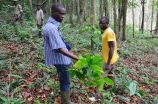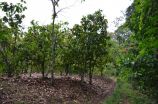(Press-News.org) COLUMBUS, Ohio - Researchers surveying for endangered primates in national parks and forest reserves of Ivory Coast found, to their surprise, that most of these protected areas had been turned into illegal cocoa farms, a new study reports.
The researchers surveyed 23 protected areas in the West African nation between 2010 and 2013 and found that about three-quarters of the land in them had been transformed into cocoa production.
The Ivory Coast is the largest producer of cocoa beans, providing more than one-third of the world's supply. Cocoa is the main ingredient in chocolate.
"The world's demand for chocolate has been very hard on the endangered primates of Ivory Coast," said W. Scott McGraw, co-author of the study and professor of anthropology at The Ohio State University.
McGraw said the original goal of this research was "just to do a census of the monkeys in these protected areas."
"But when we started walking through these areas we were just stunned by the scale of illegal cocoa production. It is now the major cause of deforestation in these parks," he said.
"There are parks in Ivory Coast with no forests and no primates, but a sea of cocoa plants."
The study (available here) appears in the March 2015 issue of the journal Tropical Conservation Science.
For the study, McGraw and his co-authors, all of whom work for Ivory Coast research institutions, spent a total of 208 days walking transects through nationally protected areas, most in the central and southern regions of the country. In each area, they noted the amount of forest that had been cut down or degraded and how much of this was replaced by cocoa or other types of farms. They also recorded the presence of 16 primate species, including monkeys and chimpanzees.
The results, McGraw said, were "depressing."
Of the 23 protected areas, 16 of them had more than 65 percent of their forests degraded by farms, logging or other human disturbance. While a variety of agricultural products were grown illegally in the parks, cocoa constituted 93 percent of the total crops grown.
Overall, 20 of the areas had illegal cocoa plantations and approximately 74 percent of the total land in these areas was transformed into cocoa production.
Unauthorized villages have sprung up within these parks, with one housing nearly 30,000 people.
"I've been doing survey work in these parks for 20 years, and it wasn't nearly this bad when I started. This is a relatively recent development," McGraw said.
The impact on primates has been dramatic.
Overall, 13 of the protected areas (57 percent) had lost their entire primate populations, while another five had lost half of their species.
One species of monkey - Miss Waldron's red colobus - was not seen during this survey and has not officially been sighted since 1978. It is probably extinct.
Two other monkeys - the Roloway monkey and the White-naped mangabey - were seen in only two reserves and are critically endangered, at least partially due to the habitat destruction caused by illegal cocoa farms.
"The Roloway monkey may be the next to go extinct," McGraw said. "It is not able to live in the degraded habitats that are left in many of these protected areas."
A variety of factors have led to these forest reserves being destroyed, he said. One has been the growing worldwide demand for chocolate. Ivory Coast produced a record 1.7 million metric tons of cocoa in the year that ended in September, according to the International Cocoa Organization in London.
Many of the older, legal cocoa plantations in the country have been blighted by disease or otherwise haven't produced at the same levels as previously, which has led some growers to establish new farms in the reserves. Moreover, migrants from outside the country have moved into Ivory Coast and turned to farming to survive.
At the same time, Ivory Coast has been in political turmoil in recent years and the government hasn't been focused on monitoring these forest reserves.
"There is little, if any, real active protection given to these parks and reserves," McGraw said. "People have moved in and settled with essentially no resistance, cut down the forest, and planted cocoa. It is incredibly blatant."
McGraw said that while the results are disappointing, there is still time to halt the disappearance of more primates and other wildlife. First, the land within protected areas needs to be actually protected.
Outside these lands, growers should move toward shade-cocoa farming, which keeps some of the large existing trees, with cocoa plants interspersed among them. This would at least preserve some suitable habitat for monkeys that live in the country, he said.
In addition, there should be efforts to connect the many fragmented forest reserves in the country. "We need to view the protected areas not as individual islands, but as a matrix," he said.
One promising development is the establishment of community-based bio-monitoring programs that involve foot patrols conducted by local villagers. McGraw said his co-authors on this paper established a patrol in the Dassioko Forest Reserve and it has succeeded in reducing illegal activity in the area. Encounter rates with primates has risen in the area as a result.
INFORMATION:
The co-authors on the study were E. Anderson Bitty, Sery Gonedele Bi, Jean-Claude Koffi Bene and Philippe K. Kouassi.
Contact: W. Scott McGraw, 614-688-3794; McGraw.43@osu.edu
Written by Jeff Grabmeier, 614-292-8457; Grabmeier.1@osu.edu
Antibodies from dromedary camels protected uninfected mice from Middle East Respiratory Syndrome (MERS), and helped infected mice expunge the disease, according to a study published online March 18th in the Journal of Virology, a journal published by the American Society for Microbiology. MERS, which emerged in humans last year in the Saudi Arabian peninsula, causes severe respiratory disease, with a high mortality rate of 35-40 percent. No specific therapy is currently available.
"Our results suggest that these antibodies might prove therapeutic for MERS patients, and ...
March 30, 2015 - Two approaches to fat grafting--injection of fat cells versus fat-derived stem cells--have similar effects in reversing the cellular-level signs of aging skin, reports a study in the April issue of Plastic and Reconstructive Surgery®, the official medical journal of the American Society of Plastic Surgeons (ASPS).
Since the facial rejuvenation results are the same, the simpler approach using fat cells plus the "stromal vascular fraction" has advantages over the more time-consuming stem cell fat technique. Dr. Gino Rigotti of Clinica San Francesco, ...
A UNSW Australia collaboration that uses previously top-secret technology to zoom through the human body down to the level of a single cell could be a game-changer for medicine, an international research conference in the United States has been told.
The imaging technology, developed by high-tech German optical and industrial measurement manufacturer Zeiss, was originally developed to scan silicon wafers for defects.
UNSW Professor Melissa Knothe Tate, the Paul Trainor Chair of Biomedical Engineering, is leading the project, using semiconductor technology to explore ...
An unusual and very exciting form of carbon - that can be created by drawing on paper- looks to hold the key to real-time, high throughput DNA sequencing, a technique that would revolutionise medical research and testing.
Led by Dr Jiri Cervenka and PhD candidate Nikolai Dontschuk from the University of Melbourne, the study also included scientists from the Australian Synchrotron and La Trobe University and is published in Nature Communications.
The Australian researchers have shown that graphene- a one-atom thick sheet of hexagonally arranged carbon, shaped like chicken ...
An observational study by Sahlgrenska Academy researchers at a large Swedish hospital found 2,393 opportunities for hand disinfection and/or aseptic techniques. Doctors and nurses missed 90% of the opportunities.
A new study at Sahlgrenska Academy, University of Gothenburg, is attracting a great deal of attention in the healthcare and research community. The study shows that the use of hand disinfection and aseptic techniques during risk-prone invasive procedures is very low.
Direct observations
Performed at a large Swedish hospital, the study is the first of its kind ...
Physicists at the Universities of Bonn and Cambridge have succeeded in linking two completely different quantum systems to one another. In doing so, they have taken an important step forward on the way to a quantum computer. To accomplish their feat the researchers used a method that seems to function as well in the quantum world as it does for us people: teamwork. The results have now been published in the "Physical Review Letters".
When facing big challenges, it is best to work together. In a team, the individual members can contribute their individual strengths - to ...
Coast redwoods are famous for being the tallest trees in the world, but their height is not the only thing that sets them apart. Unlike most conifer trees, coast redwoods can reproduce by sprouting from cut stumps, fallen logs, and roots. Researchers from the University of California, Berkeley, are uncovering important information about patterns of coast redwood clones with a new DNA analysis method that could help forest management and preservation efforts.
The new method, described in a recent issue of Applications of Plant Sciences, will enable scientists to identify ...
Northridge, CA (March 30, 2015) - A recent analysis published in the Journal of Human Nutrition & Food Science reveals a beneficial relationship between dietary magnesium intake and diabetes-related outcomes including decreased risk for metabolic syndrome, obesity or overweight, elevated blood pressure, and reduced HDL (good) cholesterol(1).
This secondary analysis examined the relationship between dietary magnesium intake from food and food combined with supplements and diabetes and other related health factors in adults (? 20 years) using data from the National Health ...
RENO, Nev. - New research into the changing ecology of thousands of shallow lakes on the North Slope of Alaska suggests that in scenarios of increasing global temperatures, methane-generating microbes, found in thawing lake sediments, may ramp up production of the potent greenhouse gas - which has a global warming potential 25 times greater than carbon dioxide.
A study published this month in Geobiology - resulting from five-years of collaborative research led by Nevada's Desert Research Institute (DRI) and including scientists from NASA's Jet Propulsion Laboratory (JPL), ...
March 30, 2015 - There are few global public health issues of greater importance than antimicrobial resistance in terms of impact on society. Many existing antimicrobials are becoming less effective and the development pipeline for new antibiotics is at an all-time low. Thus, change is needed to address antimicrobial resistance. This complex global public health challenge is tackled in a timely special focus issue of Future Microbiology, a peer-reviewed journal published by Future Medicine Ltd.
Modern medicine relies on the widespread availability of effective antimicrobials ...


